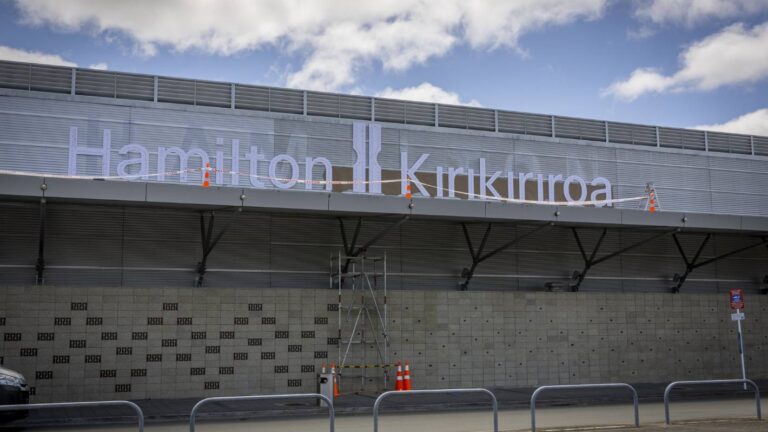Christel Yardley/Stuff
Almost there – the finishing touches are being put on the new signage at the airport, which is due to be finished by Tuesday night.
He tohu o ngā wā ināianei – it’s a sign of and for the times.
By Tuesday night, a big bilingual Hamilton Kirikiriroa sign will be finished and adorn the main terminal building at the airport. Kirikiriroa is the Māori name for the city.
The sign’s erection is the latest in a series of significant steps Waikato Regional Airport Ltd has been taking to better reflect te ao Māori (the Māori world) over the past few years.
The new signage, costing around $50,000, isn’t an “official” name change for the airport, chief executive Mark Morgan said.
READ MORE:
* Newlyweds cleared for takeoff at Hamilton Airport
* Check out the check-in – Hamilton Airport’s $15m post-Covid makeover
RNZ
Chief executive Greg Foran said they were expecting half a dozen planes to arrive over the next seven months. Video first published November 1 2022.
But, based on his personal recommendation to the board, it is a completion of its policy of having bilingual signage there.
“We’ve made a conscious effort to have bilingual signage inside the terminal.
“So we’ve thought it’s appropriate to have a bilingual sign on top,” Morgan said Monday.
There will also be an airport symbol between the two words.
Christel Yardley/Stuff
Airport chief executive Mark Morgan in front of the nearly finished new branding says “we’ve thought it’s appropriate to have a bilingual sign on top”.
Morgan said the naming move followed discussions with environmental consultant and city council Maangai Māori Norm Hill and design specialist Eugene Kara of Ngāti Koroki Kahukura, who’s been closely involved in the new Māori artworks installed as part of a recent $15 million terminal re-design.
No official name change to the airport – owned by five of the region’s local councils – is currently being discussed, he added.
The new signage “almost completes, for the moment, the journey we’ve been on that the airport reflects the cultural gateway to the mighty Waikato”.
“The company has been on a journey of discovery around te reo and the importance of the Māori culture and the Kīngitanga.
“It just felt that it completed the work we’ve undertaken with the terminal refurbishment.”
It also “shows the respect the company has for Māoridom”, he added.
Christel Yardley/Stuff
Airport leaders wanted to avoid tokenism, chief executive Mark Morgan said, and not “look like we were just putting ‘ngā mihi’ on our signatures”.
Morgan noted the recent work was a once in 20-year opportunity to do a refurbishment and re-brand in a culturally appropriate way, in a modern context.
As a pākeha, he felt it important to make changes authentically, avoid tokenism and do things right when it came to appreciating te ao Māori.
“We didn’t want to look like we were just putting ‘ngā mihi’ on our signatures.”
To any naysayers who might suggest the recent work was a waste of time “I would say come and experience the terminal”, said Morgan.
People had used words like “restful” and “manaakitanga” (caring) when they experienced the new environment. He believed once all the cultural works are installed people will generally walk in and see it as an “enhanced” space.
“To the naysayers, we haven’t just changed the sign.”
On what he’s gained personally from doing things differently, Morgan said: “It’s broadened my understanding that this [working with Māori on change] doesn’t have to be a challenging process.”
Christel Yardley/Stuff
There’s already bilingual signange in many parts of the airport, chief executive Mark Morgan said (file photo).



